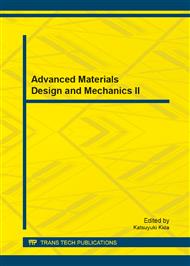p.297
p.301
p.305
p.309
p.314
p.321
p.325
p.331
p.336
Analysis of Effects of High Temperature and Loading Frequency on Asphalt Binder
Abstract:
Based on the theory of viscoelasticity, the Dynamic Shear Rheology test is used as study method. Study subjects are AH70 asphalt, SBS modified asphalt and MAC modified asphalt. Study objective is to analyze the effects of both high temperature and loading frequency on asphalt binder in asphalt mixture. Results from studies have revealed that: At high temperature and low loading frequency, the elasticity of asphalt binder decreases or low possibility of strain recovery, rutting resistance parameter decreases or the risk of rutting increases; At high temperature and high loading frequency, the viscosity of asphalt binder decreases or the strain speed of asphalt binder increases; At low temperature and high loading frequency, the fatigue resistance parameter increases, in other words there exists high fatigue cracking potential.
Info:
Periodical:
Pages:
314-317
Citation:
Online since:
August 2013
Authors:
Price:
Сopyright:
© 2013 Trans Tech Publications Ltd. All Rights Reserved
Share:
Citation:


